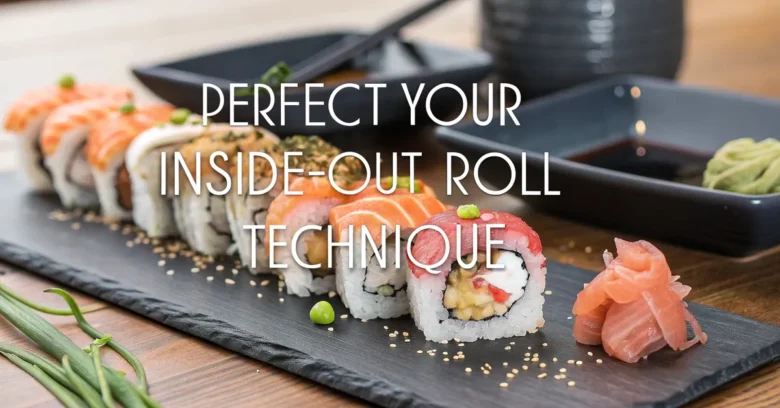Crafting sushi at home can be a fun and rewarding experience. Ever tried making those eye-catching inside-out rolls, also known as Uramaki? Many find this technique tricky, yet it unlocks a world of culinary creativity in the realm of sushi. The following article will provide a comprehensive guide that will allow you to achieve perfection when making inside out rolls.
Perfect Your Inside-Out Roll Technique
What is an Inside-Out Roll?
Before diving into the how-to, let’s define what makes an inside-out roll unique. The most recognizable element is the rice being on the exterior and the nori on the interior. You might be more used to seeing the seaweed wrap on the outside, but inside out rolls offer a different texture and visual appeal. Because of the rice on the exterior, it is common to see the rice coated in toppings such as sesame seeds, tobiko, or masago.
The Appeal of Uramaki
Uramaki, or inside-out rolls, gained popularity for a reason. There are many reasons for their popularity, and here are a few:
- Texture Play: The soft rice on the outside creates a pleasant contrast with the nori and the fillings.
- Versatility: You can create endless flavor combinations with various fillings and toppings.
- Visual Charm: The colorful toppings on the rice add an aesthetic element that makes them appealing.
- Beginner-Friendly: They’re a good starting point for those new to sushi making, as they’re generally easier to roll than traditional rolls.
Essential Tools and Ingredients
To make inside out rolls, you’ll need some specific tools and ingredients. Gather these to ensure a smooth and successful sushi-making session.
Must-Have Tools
- Sushi Rolling Mat (Makisu): A bamboo mat is essential for shaping the roll.
- Rice Cooker: Properly cooked sushi rice is the foundation of any good roll.
- Sharp Knife: A sharp knife is required for cleanly slicing the rolls.
- Cutting Board: Use a clean cutting board for ingredient prep and roll slicing.
- Rice Paddle (Shamoji): This is used for mixing and serving the sushi rice.
- Small Bowl of Water (Tezu): Keep your hands moist to prevent rice from sticking.
Key Ingredients
- Sushi Rice: Short-grain Japanese rice is ideal. It has the right starch content for achieving the desired stickiness.
- Rice Vinegar: Seasoned rice vinegar adds flavor and helps preserve the rice.
- Nori Seaweed Sheets: These sheets act as the inner wrapper for your ingredients.
- Fillings of Choice: Options include avocado, cucumber, crab sticks, cooked shrimp, smoked salmon, tuna, etc.
- Toppings: Sesame seeds (white and black), tobiko (flying fish roe), or masago (smelt roe) add flavor and visual appeal.
- Soy Sauce, Wasabi, and Ginger: These are common condiments for serving with sushi.
Preparing Sushi Rice: The Foundation
The perfect inside out roll starts with perfect sushi rice. Here’s how to achieve it.
Rinsing the Rice
- Place the rice in a bowl.
- Add cold water and gently swirl the rice with your hand.
- Drain the cloudy water.
- Repeat this process 3-4 times until the water runs clear. This removes excess starch, resulting in better texture.
Cooking the Rice
- Place the rinsed rice in a rice cooker.
- Add water according to your rice cooker’s instructions (usually a 1:1 rice to water ratio).
- Cook the rice.
Seasoning the Rice
- While the rice is cooking, prepare the sushi vinegar mixture. The following is a common formula:
- 4 tablespoons rice vinegar
- 2 tablespoons sugar
- 1 teaspoon salt
- Combine the ingredients in a small saucepan.
- Heat gently over low heat, stirring until the sugar and salt dissolve. Do not boil.
- Remove from heat and let it cool.
- Once the rice is cooked, transfer it to a large bowl.
- Pour the vinegar mixture over the rice.
- Use a rice paddle to gently mix the vinegar into the rice, being careful not to crush the grains.
- Fan the rice while mixing to help it cool quickly and achieve a glossy sheen.
- Cover the rice with a damp cloth to prevent it from drying out.
Mastering the Rolling Technique
Now comes the most important part: rolling the inside out roll. This requires some technique, but with practice, you will improve.
Preparing the Rolling Mat
- Place the bamboo rolling mat on a flat surface.
- Cover the mat with plastic wrap. This prevents the rice from sticking and makes cleanup easier.
Layering the Rice
- Take a sheet of nori.
- Place it on the prepared rolling mat.
- Evenly spread a layer of sushi rice over the nori. Use your wet fingers to prevent the rice from sticking. Aim for about a ¼-inch thickness.
- Flip the nori sheet so that the rice side is facing down on the plastic wrap. Now, the nori should be on top, ready for the fillings.
Adding the Fillings
- Arrange your fillings horizontally across the center of the nori sheet.
- Don’t overfill, as this can make it difficult to roll tightly.
Rolling the Sushi
- Lift the edge of the rolling mat closest to you.
- Fold it over the fillings, tucking the edge of the nori under the fillings to secure them.
- Continue rolling forward, applying gentle pressure to create a tight, compact roll.
- Once the roll is complete, use the rolling mat to shape and compress it firmly.
Adding Toppings
- If you want to add toppings like sesame seeds or tobiko, spread them on a flat surface.
- Gently roll the sushi roll over the toppings so they adhere to the rice.
Slicing and Serving
- Moisten your sharp knife with water before slicing. This prevents the rice from sticking to the knife.
- Cut the roll in half.
- Line up the two halves and cut them into even pieces.
- Serve the sushi with soy sauce, wasabi, and pickled ginger.
Tips for Success
Achieving the perfect inside-out roll requires practice and attention to detail. Here are some tips to help improve your technique.
Rice Consistency
- Don’t Overcook: Rice that is too mushy will be difficult to work with.
- Proper Seasoning: Ensure the rice vinegar mixture is balanced for optimal flavor.
- Cooling: Allow the rice to cool slightly before rolling to prevent the nori from becoming soggy.
Filling Considerations
- Freshness: Use only the freshest ingredients for the best taste and texture.
- Balance: Combine different textures and flavors in your fillings for a well-rounded roll.
- Preparation: Cut your fillings into uniform sizes for even distribution and easier rolling.
Rolling Technique
- Tight Rolls: Apply gentle pressure while rolling to ensure a compact and visually appealing roll.
- Even Pressure: Keep the pressure even to avoid uneven rolls.
- Practice: The more you practice, the better you’ll get at mastering the rolling technique.
Topping Application
- Even Distribution: Ensure toppings are evenly spread for a uniform look.
- Adhesion: Lightly press the toppings into the rice to help them adhere better.
- Variety: Experiment with different toppings to add unique flavors and textures.
Troubleshooting Common Issues
Even with careful preparation, problems can occur. Here are some common problems encountered when making inside out rolls, along with solutions.
Rice Sticking to the Mat
- Problem: Rice sticks to the bamboo rolling mat, making it difficult to shape the roll.
- Solution: Ensure the rolling mat is properly covered with plastic wrap. Also, keep your hands wet while handling the rice.
Roll Falling Apart
- Problem: The sushi roll falls apart after rolling or slicing.
- Solution: Make sure you are rolling the sushi tightly and applying even pressure. Also, ensure the rice is sticky enough to hold the ingredients together.
Soggy Nori
- Problem: The nori becomes soggy and loses its crispness.
- Solution: Avoid using overly hot rice, as this can steam the nori. Also, ensure you’re not adding overly wet fillings.
Uneven Rolls
- Problem: The sushi roll is not uniform in shape.
- Solution: Pay attention to even distribution of the rice and fillings. Use the rolling mat to shape the roll consistently.
Creative Variations
Once you’ve mastered the basic inside-out roll, let your creativity soar with these unique twists.
Spicy Tuna Roll
- Mix cooked sushi-grade tuna with sriracha mayo and a touch of sesame oil.
- Add avocado and cucumber as fillings.
- Top with sesame seeds or tempura flakes for added crunch.
California Roll
- Use imitation crab meat (kani kama), avocado, and cucumber as fillings.
- Top with tobiko or masago for a classic look and texture.
Rainbow Roll
- Fill the roll with crab, avocado, and cucumber.
- Top the roll with an assortment of thinly sliced fish such as tuna, salmon, yellowtail, and avocado for a vibrant look.
Vegetable Roll
- Use a mix of colorful vegetables such as bell peppers, carrots, and sprouts.
- Add avocado for creaminess.
- Top with sesame seeds or a sprinkle of seaweed flakes.
Health Benefits of Inside-Out Rolls
Beyond their great taste and visual appeal, inside out rolls can offer several health benefits, depending on the ingredients you choose.
Nutritional Value
- Sushi Rice: Provides carbohydrates for energy.
- Nori Seaweed: Rich in minerals and antioxidants.
- Fish (Salmon, Tuna): Excellent source of omega-3 fatty acids and protein.
- Avocado: Healthy fats, vitamins, and minerals.
- Vegetables (Cucumber, Carrots): Add fiber and essential nutrients.
Potential Benefits
- Heart Health: Omega-3 fatty acids in fish support cardiovascular health.
- Brain Function: Omega-3s also benefit brain function and may improve mood.
- Digestive Health: Fiber from vegetables promotes healthy digestion.
- Nutrient Rich: A well-balanced inside-out roll provides essential vitamins and minerals.
Considerations
- Sodium: Be mindful of the sodium content in soy sauce and some fillings.
- Mercury: Limit consumption of high-mercury fish such as some types of tuna.
- Allergies: Be aware of potential allergens in ingredients like shellfish or sesame seeds.
Elevate Your Sushi Game
Making inside-out rolls is more than just a culinary skill, it’s an art form that combines precision, creativity, and flavor. With the tips and techniques shared, you can create impressive sushi right in your own kitchen. Why not grab your rolling mat and start experimenting with different fillings and toppings? Remember, practice makes perfect!



